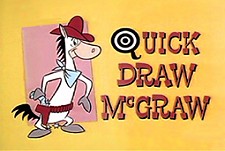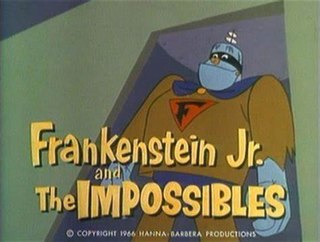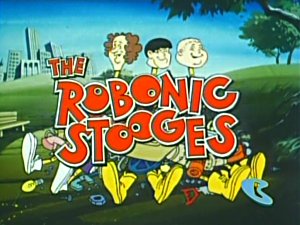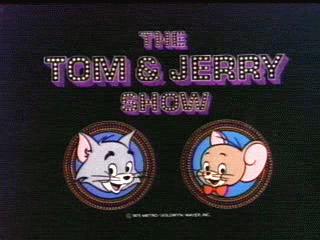
Abbott and Costello were an American comedy duo composed of comedians Bud Abbott and Lou Costello, whose work in radio, film, and television made them the most popular comedy team of the 1940s and 1950s, and the highest-paid entertainers in the world during the Second World War. Their patter routine "Who's on First?" is considered one of the greatest comedy routines of all time, a version of which appears in their 1945 film The Naughty Nineties.

The Dukes is a 30-minute Saturday morning animated series based on the live-action television series The Dukes of Hazzard which aired on CBS from February 5 to October 29, 1983. Hanna-Barbera Productions produced the series in association with Warner Bros. Television, producer of the original series. 20 episodes were produced.

The Ruff and Reddy Show is an American animated television series produced by Hanna-Barbera Productions for NBC. It is one of the earliest Saturday-morning cartoons, and the first series made by Hanna-Barbera. The series follows the adventures of Ruff, a smart and steadfast cat; and Reddy, a good-natured and brave dog. It was presented by Screen Gems, the television arm of Columbia Pictures. It premiered in December 1957 and ran for 156 episodes until April 1960, comprising three seasons total. It was repeated on NBC Saturday mornings in 1962–63. In the late 1950s it was sponsored by Post Consumer Brands.

The Quick Draw McGraw Show is an American animated television series produced by Hanna-Barbera Productions, and their third television series overall after The Ruff and Reddy Show and The Huckleberry Hound Show. Voice actor Daws Butler performed the show's title character, Quick Draw McGraw.
The Scooby-Doo/Dynomutt Hour is a 60-minute package show produced by Hanna-Barbera Productions in 1976 for ABC Saturday mornings. It marked the first new installments of the cowardly canine since 1973, and contained two segments: The Scooby-Doo Show and Dynomutt, Dog Wonder.
Where's Huddles? is an American animated sitcom produced by Hanna-Barbera Productions that premiered on CBS on July 1, 1970. It ran for ten episodes as a summer replacement show for Hee Haw, until September 2.

Wally Gator is an American animated television series produced by Hanna-Barbera Productions that originally aired as one of the segments from the 1962–1963 block The Hanna-Barbera New Cartoon Series. The other two segments that compose the series are Touché Turtle and Dum Dum and Lippy the Lion and Hardy Har Har. The segment consisted of 52 episodes over one year. Wally Gator appears in the HBO Max series Jellystone! where he is portrayed as the town ditz and played by Jeff Bergman.

The New Adventures of Batman is an animated series that aired on CBS from February 12 to May 28, 1977, featuring the DC Comics superheroes Batman and Robin, and Batgirl. The series was a Filmation and DC Comics production in association with Warner Bros. Television.

The New Scooby-Doo Movies is an American animated mystery comedy television series produced by Hanna-Barbera for CBS. It is the second television series in Scooby-Doo franchise, and follows the first incarnation, Scooby-Doo, Where Are You! It premiered on September 9, 1972, and ended on October 27, 1973, running for two seasons on CBS as the only hour-long Scooby-Doo series. Twenty-four episodes were produced, sixteen for the 1972–73 season and eight more for the 1973–74 season.

Jeannie is an American animated television series that originally aired for a 16-episode season on CBS from September 8 to December 22, 1973. It was produced by Hanna-Barbera in association with Screen Gems, and its founders William Hanna and Joseph Barbera are the executive producers. Despite being a spin-off of sorts of the television sitcom I Dream of Jeannie, Jeannie has little in common with its parent show. In this version, the title character is rescued on the beaches of southern California by a high school student, Corey Anders. Jeannie is accompanied by genie-in-training Babu, and they become companions to Corey and his best friend, Henry Glopp, both of whom also help Jeannie and Babu adjust to their new home as well as life in Los Angeles. The series was marketed towards a younger demographic than I Dream of Jeannie.

Speed Buggy is an American animated television series, produced by Hanna-Barbera, which originally aired for one season on CBS from September 8, 1973, to December 22, 1973. With the voices of Mel Blanc, Michael Bell, Arlene Golonka, and Phil Luther Jr., the show follows an orange anthropomorphic dune buggy who alongside teenagers Debbie, Mark, and Tinker, solves mysteries while participating in racing competitions around the world. The series was produced by Iwao Takamoto, executive produced by William Hanna and Joseph Barbera, and directed by Charles A. Nichols.
The Completely Mental Misadventures of Ed Grimley is an American animated television series produced by Hanna-Barbera Productions and featuring Martin Short's fictional character Ed Grimley. The show aired on NBC from September 10 to December 3, 1988 for a single season of 13 episodes. The show is the only Saturday morning animated adaptation of both an SCTV character and a Saturday Night Live character, and the first Saturday morning cartoon featuring an SCTV cast member.

Frankenstein Jr. and The Impossibles is an American animated television series produced by Hanna-Barbera Productions. It premiered on September 10, 1966 on CBS, and ran for two seasons on Saturday mornings.

The Fantastic Four is an American animated television series produced by Hanna-Barbera Productions and based on the Marvel Comics superhero team of the same name. The program, featuring character designs by Alex Toth, aired Saturday mornings on ABC from September 9, 1967, to September 21, 1968. It lasted for 20 episodes, with repeat episodes airing on ABC for three years until the network cancelled the program. It was also rerun as part of the continuing series Hanna–Barbera's World of Super Adventure.

The New Adventures of Superman is a series of six-minute animated Superman adventures produced by Filmation that were broadcast Saturday mornings on CBS from September 10, 1966, to September 5, 1970. The 68 segments appeared as part of three different programs during that time, packaged with similar shorts featuring The Adventures of Superboy and other DC Comics superheroes.

The Robonic Stooges is a Saturday morning animated series featuring the characters of The Three Stooges in new roles as clumsy crime-fighting cyborg superheroes. It was developed by Norman Maurer and produced by Hanna-Barbera Productions from September 10, 1977, to March 18, 1978, on CBS and contained two segments: The Robonic Stooges and Woofer & Wimper, Dog Detectives.
Devlin is an American animated television series produced by Hanna-Barbera Productions and broadcast for 16 episodes on ABC from September 7 to December 21, 1974, with reruns airing until September 1976. The series, inspired by the popularity of motorcycle daredevil Evel Knievel, featured a stunt motorcyclist with a traveling circus named Ernie Devlin and his siblings Tod and Sandy. It was one of Hanna-Barbera's few dramatic series.
The Hanna-Barbera New Cartoon Series, a.k.a. The New Hanna-Barbera Cartoon Series or The Wally Gator Show, was a syndicated television package of animated cartoon series produced by Hanna-Barbera Productions, starting in 1962. The show included three unrelated short cartoon segments featuring talking animal characters:

Laurel and Hardy is a 1966-1967 American animated television series and an updated version of Stan Laurel and Oliver Hardy's comedic acts by the animation studio Hanna-Barbera and Larry Harmon Productions. Harmon had been developing the series since 1961, while Stan Laurel was still alive, although Laurel had very little involvement.

The Tom & Jerry Show is an American animated television series produced by Hanna-Barbera Productions in association with MGM Television. Based on the Tom and Jerry theatrical cartoon series, which was created by H-B co-founders and former MGM cartoon studio staff William Hanna and Joseph Barbera, the show originally aired on ABC from September 6 to December 13, 1975 as the first half of The Tom and Jerry/Grape Ape/Mumbly Show, with The Great Grape Ape Show representing the series' second half and The Mumbly Cartoon Show representing the series' third half. This series marked the first time that Tom and Jerry appeared in animated installments produced specifically for television.















